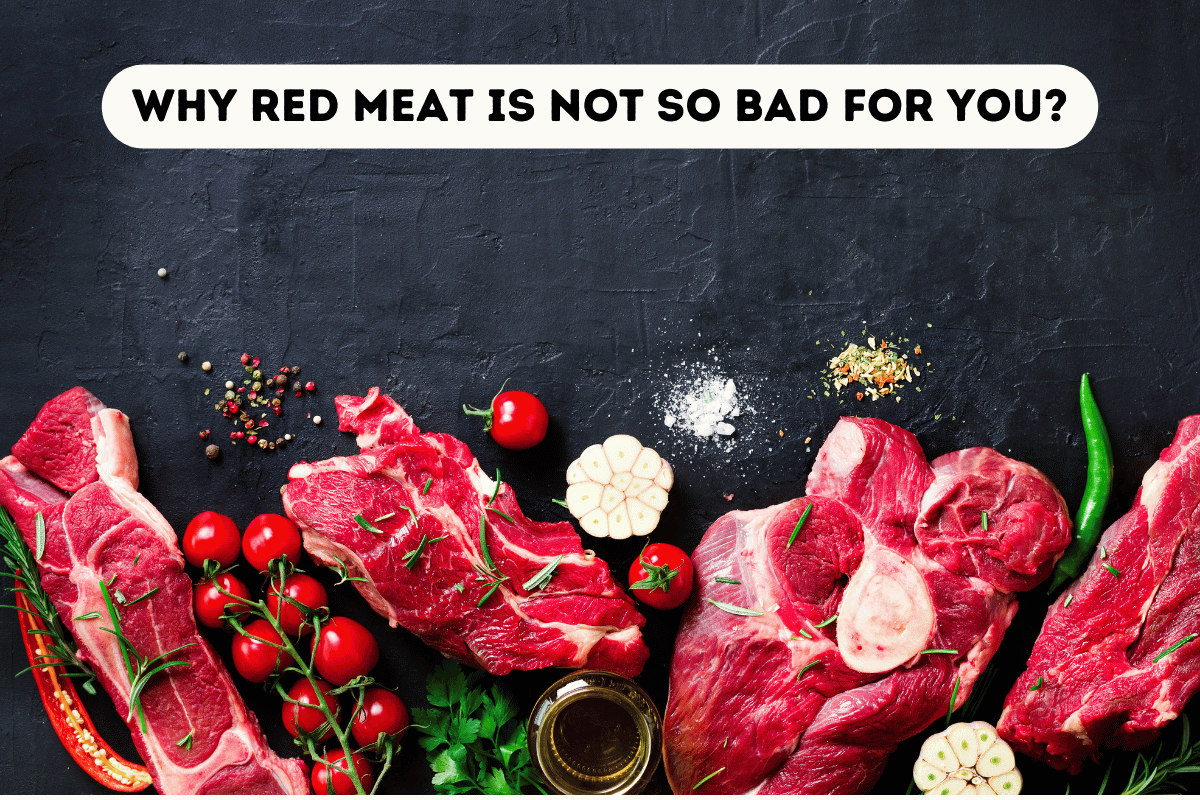Very long-time red meat was associated with heart disease and bowel cancer. Consuming red meat was discouraged for many years, but now research is telling us that it may not be as harmful as we thought. First, observational studies (mainly used for nutritional research) are not always accurate and can give us wrong information. Secondly, red meat is very nutritious (it contains complete proteins, vitamin B12, niacin (Vitamin B3), zinc, selenium, iron, and other nutrients). Also, grass-fed versions of red meat contain omega-3 fatty acids, and saturated fat with cholesterol isn’t as harmful as once thought. Of course, there are specific precautions about eating red meat. How healthy it is to eat the meat depends on the type of red meat and how it is cooked. Now, let’s look at everything separately.
Different types of the meat.
Before we discuss the benefits and precautions of eating red meat, we need to understand the difference between different meats. Red meat comes from animals such as beef, pork, and lamb and is red when it’s raw. Meat from birds like chicken and turkey is white meat and is white when it’s cooked. Also, how these animals were raised is essential because it affects the quality of the animal meat.
- Conventional meats. We get such meat from animals raised at factory farms. They are usually not raised in the best conditions and are fed with grain-based feeds. All red meat that is not labeled as organic or grass-fed is always conventional. It has more omega 6 fatty acids and a slightly lower quality than grass-fed or organic.
- Grass-fed meat. This meat comes from cows that are not raised in factory farms. They live in better conditions. They graze in fields, enjoy the sunshine and eating grass. Such animals are fed partly with grains as well. The meat of such cows contains more omega-3 fatty acids.
- Organic meat. This type of meat comes from 100% organic feed and forage. They are not raising in factory farms and grazing in their natural environment. Also, they don’t receive antibiotics and hormones. Type of these meat is the best choice for health.
- Processed meats. These meats are mostly processed using various methods, such as smoking, salting, curing, and drying. They are conventional meats, and examples include bacon, hot dogs, sausages, and so on.
- Unprocessed meats. These types of meat weren’t processed at all or just lightly. Examples include ground beef and sirloin.
Benefits of eating red meat.
The most significant benefit of eating red meat is that it is very high in valuable nutrients. You get nutrients like Vitamin B12, Zink, Selenium, Niacin (Vitamin B3), and Iron by eating red meat. Vitamin B12 is necessary for the normal function of the nerve function and the formation of red blood cells (you can’t find B12 in the plant products). Zink is necessary for the body’s growth and maintenance and helps to immune and metabolism functions. Selenium is a powerful antioxidant, which helps to lower oxidative stress in the body and reduce inflammation. Iron is essential for making red blood cells, which carry oxygen around the body. The best source of iron, which is better absorbed in the body, is heme iron, which can be found in animal products. In the plant’s products, there is just non-heme iron, which don’t absorb properly in the body.
Red meat’s protein is complete, which means our body is getting all necessary amino acids for muscle and tissue growth and maintenance. Protein is essential in our diet. It helps reduce appetite and increase metabolism, which can help lose fat. Protein helps to increase muscle mass and make our bones stronger. Other essential nutrients that red meat contains are creatine, which is an energy source for muscles (bodybuilders are using creatine supplements for muscle growth and maintenance) and taurine, which is vital for heart and muscle functions. Also, grass-fed versions of red meat contain omega-3 fatty acids.
As you can see, red meat has many benefits for our bodies. It provides us with lots of valuable nutrients, some of which cannot be found in plants. These nutrients are more bioavailable (absorbed better in our bodies). Red meat supplies us with good-quality protein, omega-3 fatty acids, and many other things. On the other hand, if we overeat processed meat and use the wrong cooking method, it can damage our health by creating heart problems and bowel cancer.
Accuracy of observational studies.
The majority of studies done for nutritional research are observational studies. During these studies, scientists ask people what and how much they have eaten in a given period. Then, scientists follow these people for years to see how many of them get a disease or die. A lot of times, people’s diet is assessed only once. Sometimes, better studies ask people to report their diets multiple times, which can take into account changes, but self-reported dietary data is known to be poor. People may remember what they ate but have trouble remembering how much or how it was prepared. All of these factors can affect the value of the study. Even if a member of observational studies shows similar results, evidence is still weak. It is crucial to understand that in observational studies people are not monitored 24/7. This means that the data people give for observational studies can be wrong, and it isn’t easy to check how accurate it is.

Also, an important fact to consider is that people who decide to stop eating meat mostly do this to become healthier. So, people who get rid of meat will probably drink less alcohol, quit smoking, and exercise more regularly. Meat eaters, on the other hand, tend to drink more alcohol, smoke and be less active. An important question to ask here is: “Maybe meat is not a bad guy, maybe high alcohol consumption, smoking, and not enough physical activity are the problems? And maybe if meat eaters would stop smoking, drinking and start exercising regularly, it would improve their health without cutting meat out of their diet?” So, all in all, this shows how misleading observational studies can be, and we must look at them with a pinch of salt.
The best studies are randomized controlled trials in which people are randomly assigned to various groups. Such studies are used primarily in medical science. They take two groups of people. To one group, they give a drug that could help them, and to the other group, they give a placebo. If the drug works better than the placebo, then the drug is effective. In these studies, they look after people 24/7, which means studies are done with more accuracy.
Unfortunately, using the same studies for nutrition is complex. Sticking to a diet is challenging, especially for a very long time, and it would be very expensive to do such a study. This is the problem why we have so much misunderstanding about what’s healthy and what is not. One year, scientists tell us that red meat is bad for your health, but another year, it is already not so dangerous and can even be beneficial.
Here, we can conclude that the best studies are randomized controlled trial studies, and observational studies can be misleading. Actually, there are numerous situations where observational studies have shown a protective effect of nutrients, but in randomized studies, it was disproven. So, where is the truth? Is red meat healthy for us? I believe that truth is always somewhere in the middle. Red meat can be healthy for us because it has many health benefits, but overeating processed meat and using the wrong cooking method can damage our health.
Downsides of eating red meat.
If we look at observational studies about meat consumption, we will see that eating red meat can cause heart disease and bowel cancer. According to observational studies, red meat can cause heart disease because of the high amount of saturated fat and cholesterol there. Bowel cancer is associated with getting too much heme iron from red meat, which can create cancer cells. Iron is necessary for our body, but overconsumption is dangerous as well. Eating meat using high temperature cooking can also generate cancer cells, especially when we are frying, baking, or grilling meat. The best cooking methods for meat are steaming, boiling, and stewing.
Speaking about saturated fat, what people don’t understand, there are many types of saturated fats, all with different effects on health. Unfortunately, in many observational studies, when they were done, they grouped processed and unprocessed red meats together, making it more difficult to find an answer: “Is red meat healthy for us or not?”. Because of this, for a long time, it was believed that eating red meat could cause heart disease and bowel cancer, but now research is finding out that not all red meats are bad for your health. Everything depends on the type of meat and cooking method you are using. As we saw above, the best kind of meat is unprocessed organic or grass-fed meat. Conventional meats have lower quality, and you could reduce their consumption slightly. And Processed meats should be avoided.
Now, when we look at science, it shows us that high intake of processed meat (150 or more grams per week) can significantly increase the risk of death and heart disease. Processed meats may cause heart disease because of high salt content which can increase blood pressure as well. On the other hand, some studies show that unprocessed red meat, even in amounts of 250 grams per week, didn’t show any association between red meat consumption and heart disease.
Why dietary cholesterol is not so bad for you?
Before, science used to tell us that overeating dietary cholesterol can raise our blood cholesterol levels, increasing the risk of heart disease. So, we decided that cholesterol was the bad guy as well. But it’s not true. Actually, without cholesterol, we could not survive. Our body needs cholesterol for many different body functions, including various hormones and vitamin D production. Our body can make all the cholesterol it needs but absorbs some amount from food like eggs, red meat and full-fat dairy products. Mostly, when everybody speaks about cholesterol, they mean lipoproteins. Lipoproteins are structures that carry cholesterol in the bloodstream. There are two main types of lipoproteins:
- Low-density lipoproteins (LDL) are responsible for carrying cholesterol particles through the body. They are also called bad cholesterol. Our cells need this cholesterol, but if we have too much of it in our blood, it can create plaque in the arteries. The higher the level of LDL, the greater the risk of heart disease.
- High-density lipoproteins (HDL) help to pick up excess cholesterol throughout the body and bring it back to the liver, where it can be used or excreted. Because HDL helps to reduce LDL, it is called good cholesterol and is associated with decreased risk of heart disease.

It can seem logical that eating cholesterol-rich foods will increase blood cholesterol levels, but in reality, it is more complicated. Cholesterol is produced by the liver, and the liver controls how much cholesterol it produces. When we eat more cholesterol-rich foods, the liver produces less cholesterol. And when the intake of dietary cholesterol goes down, the liver produces more. So, food high in dietary cholesterol has minimal impact on the blood cholesterol levels in most people. Some people can be hyperresponsive to dietary cholesterol, primarily because of genetics. Such people should eat less dietary cholesterol and check cholesterol levels more often.
Also, it is important to mention that the liver is the organ that produces and clears cholesterol. So, if your liver is damaged, for example, you have fatty liver disease, cirrhosis, or other liver problems, it can affect your levels of LDL in the blood. In this case, the primary problem of high LDL (bad cholesterol) will be not dietary cholesterol but liver problems. And in the first place, if you want to lower your bad cholesterol levels, you should fix your liver. So, to sum up everything, dietary cholesterol is not bad for you. It has many vital functions for the body. If you are hyperresponsive to dietary cholesterol or you have a liver problem, you should be more careful with dietary cholesterol and monitor your cholesterol levels more often. You can read more about cholesterol and how you can lower your bad cholesterol levels in my article: “All you need to know about cholesterol”.
Conclusion.
So, all in all, red meat is not bad for your health; it is very nutritious, has good quality protein, can help you lose fat, and can even contain omega-3 fatty acids. But to benefit from red meat, it should be unprocessed organic or grass-fed meat. Conventional meats have lower quality, and you could reduce their consumption slightly, but don’t restrict them completely. Highly processed meats like bacon and sausages, which are high in salt and contain other preservatives, should be avoided. And don’t forget about proper cooking methods as well.




